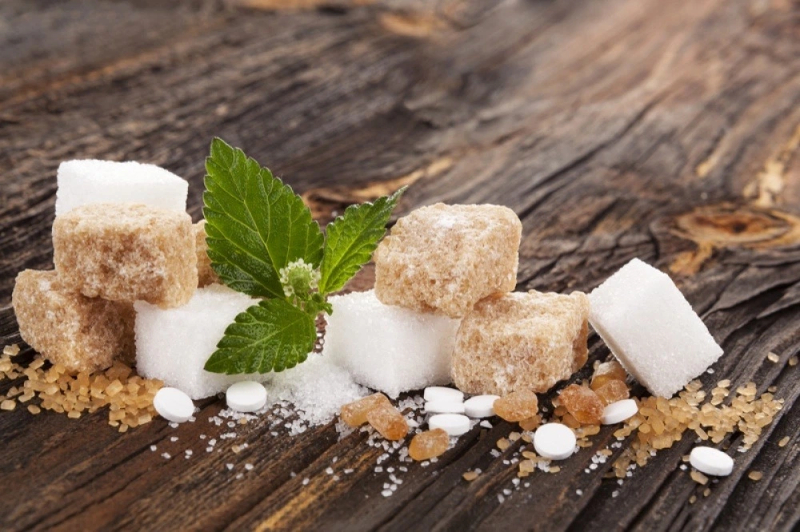Views: 222 Author: Sara Publish Time: 2025-10-24 Origin: Site








Content Menu
● Understanding the glycemic context
● Key sweeteners and their profiles
● Gaps and considerations in diabetes-focused use
● Practical guidance for product development
● Practical dietary planning with sweeteners
● Safety, research, and ongoing evaluation
● Case considerations for industrial applications
● FAQ
>> 1. What is the safest sweetener for diabetics?
>> 2. Do artificial sweeteners raise blood sugar?
>> 3. Can diabetics use sugar substitutes daily?
>> 4. Are there long-term risks associated with artificial sweeteners?
>> 5. How should a diabetes-focused product be formulated for taste and safety?
Diabetes management hinges on controlling blood glucose and cardiovascular risk, and sweet taste often complicates dietary adherence. Sweeteners—whether natural, synthetic, or Advantaged blends—offer options to reduce sugar intake while maintaining palatability in foods and beverages. This article examines which artificial and alternative sweeteners may be appropriate for diabetics, their effects on blood glucose, appetite, weight, gut microbiota, and long-term health, and how to integrate them into a balanced diet. Throughout, the emphasis remains on practical guidance for product developers and manufacturers serving international markets with health-focused solutions, including the use of natural sweeteners, functional polyols, and dietary fibers in mixed sweetener blends, tablet production, and OEM/ODM services.

- For many people with diabetes, the primary concern with sweeteners is their impact on blood glucose and insulin dynamics. Some non-nutritive or low-calorie sweeteners do not raise blood glucose acutely, while others may have nuanced effects through digestion, gut hormones, or microbiome interactions.
- In practice, choosing a sweetener often depends on the intended use (beverage, baked good, tablet, or supplement), the desired flavor profile, and any concomitant nutritional goals such as fiber enrichment or caloric reduction. This is especially relevant for manufacturers aiming to deliver complete health solutions in the food, beverage, and healthcare arenas.
- Sucralose: A widely used high-intensity sweetener with near-zero calories and minimal direct impact on blood glucose for most individuals. Some studies suggest gut microbiota interactions and potential variability in glycemic response among individuals, which may influence long-term outcomes in certain populations. For product developers, sucralose can provide stability and sweetness without contributing carbohydrates.
- Acesulfame potassium (Ace-K): Often used in combination with other sweeteners to enhance sweetness and aftertaste. Generally does not raise blood glucose acutely, but some research points to microbiome and metabolic effects in certain contexts. Formulation considerations include compatibility with baking, heat stability, and tablet manufacturing.
- Aspartame: Caloric value is low, but it contains phenylalanine, which must be avoided by individuals with phenylketonuria. It provides sweetness without appreciable blood glucose impact for most people; however, some studies have explored potential metabolic signaling effects. In tablet or stick-pack formats, stability and taste profile are critical.
- Saccharin: One of the oldest artificial sweeteners, with no calories and negligible acute glycemic impact. Historical concerns about safety have largely been resolved, but consumer perceptions and long-term effects on gut microbiota continue to be studied.
- Stevia and steviol glycosides: Plant-derived sweeteners with minimal caloric contribution and typically negligible immediate blood glucose elevation. They can have favorable effects on weight management in many populations, though some individuals report aftertaste bitterness. Stevia-based blends often pair well with polyols in complex sweetener systems.
- Erythritol and other polyols: Nearly non-caloric and have minimal impact on blood glucose and insulin. They can cause digestive intolerance in some individuals at higher doses, particularly in tablet formats or concentrated syrups. For manufacturers, polyols provide bulk and mouthfeel; pairing with flavor enhancers can optimize sensory profiles.
- Allulose and other rare sugars: Provide near-zero calories and very low glycemic response for many users. Availability and regulatory status vary by region, but growing interest exists in health-focused product lines, including functional nutrition and medical foods.

- Individual variability: Genetic, microbiome, and lifestyle differences mean that even "diabetes-friendly" sweeteners can have diverse effects on glycemic response and appetite. Product developers should consider testing in target populations and offering guidance on expected ranges.
- Gut microbiota and long-term risk: A considerable body of research explores how artificial and non-nutritive sweeteners may influence gut bacteria and metabolic signaling. While evidence is not conclusive for all sweeteners, manufacturers should be mindful of evolving science and maintain transparent labeling about potential effects.
- Cardiovascular and metabolic outcomes: Some observational studies have linked high intake of certain artificial sweeteners with cardiovascular risk or metabolic syndrome in certain cohorts. However, causation is not established, and results vary across study designs. Clear communication and responsible marketing are essential.
- Blend strategies: Use combinations of sweeteners to achieve a sugar-like taste profile, reduce aftertaste, and improve stability in various matrices (beverages, baked goods, and tablets). For example, blending a high-intensity sweetener with a bulking agent or polyol can mimic sugar's bulk and mouthfeel while maintaining a low glycemic footprint.
- Functional carbohydrates and fibers: Incorporate dietary fibers and functional polyols to improve texture, satiety, and glycemic response. This aligns with the broader health objectives of food and healthcare manufacturers seeking to deliver comprehensive health solutions.
- Tablet production: For tablet forms intended for diabetic patients or caregivers, ensure adequate disintegration, taste masking, and aroma, while maintaining sweetness levels consistent with dietary recommendations. Consider coatings or encapsulation to improve stability and palatability.
- Regulatory and labeling: Remain compliant with regional regulations on permissible sweeteners, labeling requirements, and consumer safety communications. Clear labeling helps healthcare professionals and consumers make informed choices in diabetes management.
- Quality assurance: Implement robust QA/QC protocols to verify batch-to-batch sweetness intensity, thermal stability, and compatibility with other formulation components. This is critical for OEM/ODM partnerships where consistency directly affects clinical outcomes and user satisfaction.
- Gentle integration into meals: Diabetic-friendly menus can include beverages, desserts, and snacks sweetened with approved sweeteners, provided portion sizes and total carbohydrate intake are managed within individualized plans. For manufacturers, offering ready-to-use flavoring systems and recipe kits can support healthcare providers and patients.
- Glycemic awareness: Educate consumers on the concept that "sugar-free" does not always imply zero carbohydrate impact, especially when polyols and other caloric sweeteners are used. Clear consumer education reduces misperceptions and promotes safer, more informed choices.
- Flavor consistency: Sweeteners can interact with other ingredients, affecting flavor release and aftertaste. For product developers, pilot testing with real consumer panels helps optimize sensory properties across products and markets.
- Ongoing research is essential: While many sweeteners are generally recognized as safe (GRAS) by regulatory authorities, long-term studies continue to examine potential health implications, including metabolic, hormonal, and microbiome effects. Manufacturers should monitor new evidence and update formulations as warranted.
- Balance with whole foods: Sweeteners should complement, not replace, a diet rich in fiber, vegetables, lean proteins, and healthy fats. A holistic health approach better supports glycemic control and overall well-being for diabetics.
- International markets: Regulatory landscapes differ in North America, Europe, and Asia. For a factory serving multiple regions, developing flexible blends that meet diverse regulatory standards can be a strong competitive advantage.
- OEM/ODM collaboration: Custom sweetener blends, flavored matrices, and tablet designs require close collaboration with clients. Transparent communication about sensory targets, stability, and efficacy is key to successful partnerships.
- Sustainability and natural alternatives: Increasing demand for natural or naturally derived sweeteners aligns with consumer preferences and can differentiate health-focused products. Sustainable sourcing and clear traceability enhance brand trust.
Sweeteners offer a spectrum of choices for diabetics, from artificial high-intensity sweeteners to plant-based and polyol options. The best choice depends on individual responses, product application, and long-term health goals. For manufacturers, the opportunity lies in delivering integrated health solutions—combining natural sweeteners, functional polyols, and dietary fibers in thoughtfully engineered blends—to meet the evolving needs of global diabetic populations while ensuring safety, efficacy, and consumer satisfaction.

The safest choice varies by individual tolerance and health goals. Generally, non-nutritive sweeteners such as sucralose, Ace-K, aspartame, saccharin, and stevia have little to no immediate impact on blood glucose for many individuals, though long-term metabolic considerations and gut microbiota interactions are an active area of research.[1][4]
Most artificial sweeteners do not raise blood glucose in the short term for many people with diabetes, but some studies suggest complex metabolic effects in certain individuals, including potential influences on insulin signaling and gut microbiota.[2][4]
Sugar substitutes can be part of a diabetes-friendly plan when used in moderation and within individualized carbohydrate goals, keeping in mind any digestive tolerance and personal responses to specific sweeteners.[5][8]
Observational studies have reported associations with various health outcomes, but causality is not established. Ongoing research continues to investigate potential long-term effects on metabolism, cardiovascular risk, and microbiota composition.[3][7][1]
Aim for balanced blends that minimize aftertaste, ensure heat stability for processing, and align with regulatory labeling standards. Combine sweeteners with functional fibers or polyols to improve texture and satiety while maintaining a low glycemic footprint.[6][10]
[1](https://pmc.ncbi.nlm.nih.gov/articles/PMC9655943/)
[2](https://pmc.ncbi.nlm.nih.gov/articles/PMC10465821/)
[3](https://www.sciencedirect.com/science/article/abs/pii/S1056872725000078)
[4](https://www.mayoclinic.org/diseases-conditions/diabetes/expert-answers/artificial-sweeteners/faq-20058038)
[5](https://www.webmd.com/diabetes/artificial-sweeteners-diabetes-patients)
[6](https://www.frontiersin.org/journals/nutrition/articles/10.3389/fnut.2024.1411560/full)
[7](https://www.missionhealth.org/healthy-living/blog/the-not-so-sweet-effects-of-artificial-sweeteners-on-the-body)
[8](https://health.clevelandclinic.org/are-artificial-sweeteners-safe-for-people-with-diabetes)
[9](https://www.health.harvard.edu/heart-health/sugar-substitutes-new-cardiovascular-concerns)
[10](https://professional.diabetes.org/sites/dpro/files/2023-12/sugar_substitutes.pdf)
